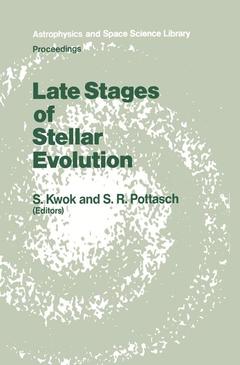Late Stages of Stellar Evolution, Softcover reprint of the original 1st ed. 1987 Proceedings of the Workshop Held in Calgary, Canada, from 2–5 June, 1986 Astrophysics and Space Science Library Series, Vol. 132
Langue : Anglais
Coordonnateurs : Kwok S., Pottasch Stuart R.

Over the last decade we have witnessed a rapid change in our understanding of the late stages of stellar evolution. A major stimulus to this has been the synthesis of observational data from different wavebands of the electromagnetic spectrum. The advent of infrared astronomy has led to the discovery of many luminous. late-type stars obscured by their circumstellar dust envelope. Sources discovered in the IRC and AFGL infrared sky surveys were followed up by radio observa tions, leading to the widespread use of the OH and CO molecules as probes of the circumstellar envelopes. Advances in the technique of aperture synthesis have made possible observations with unprecedent resolving power, both in spectral-line and continuum. The success of the recent IRAS sky survey, with the detection of over 250,000 sources, brings the promise of even more exciting years ahead. This area of astronomical research is also blessed with the close collaboration between theorists and observers. New ideas are constantly being quantitatively tested by new data. Theoretical predictions are eagerly used as guides for further observations. This conference was initiated with the following objective: bring together workers in optical, infrared, radio and theoretical astronomy and let them confront each other. Based on the post-conference res ponses we received, many of the participants have indeed found this Workshop a stimulating experience. The Workshop on the Late Stages of Stellar Evolution was held from 2-5 June 1986 in Calgary, Canada.
Section 1. Observations of OH/IR and Mira Stars.- Infrared Observations of Radio Luminous OH/IR Stars (invited review).- High Spatial Resolution IR Observations of Evolved Stars (invited review).- Mira Variables and the Galactic Bulge Population (invited review).- Mass Loss From Red Giants: Infrared Spectroscopy (invited review) (abstract only).- Identification of Cool IRAS Sources.- The Period-Luminosity Relationship for Mira-Like Variables in the LMC.- Distances, Luminosities, and Shell Structures of OH/IR Stars (invited review).- High Resolution Radio Observations of OH/IR Stars (invited review) (abstract only).- Identification of OH/IR Stars from Color Selected IRAS Sources.- OH/IR Stars in the Galactic Centre.- 1612 Mhz Survey of Selected IRAS Point Sources.- The Kinematic Nature and Evolution of OH/IR Maser Sources.- A Search for Water Maser Emission from OH/IR Stars.- Non-Variable OH/IR Stars/ Very Young Planetary Nebulae?.- A Study of Dust Condensation Around M Mira Variables Based on IRAS LRS Observations.- Section 2. Observations of Carbon Stars.- Mass Loss from Carbon Stars — Observations of the CO Millimeter Wavelength Rotational Lines.- Interferometric Observations of Circumstellar Envelopes at Millimeter Wavelengths.- The Distribution of Carbon-rich Circumstellar Envelopes in the Milky Way.- IRAS LRS Spectra of Cool Carbon Stars: Clues of Carbon Star Evolution.- Millimeter Interferometer Mapping of HCN Toward CRL2688.- CO Observations of IRAS Sources with SiC Emission Features.- High-Sensitivity HI Observations of the Circumstellar Envelopes of ? Orionis and IRC+10216.- CCD Observations of IRC +10 216.- Carbon Grains in the Circumstellar Envelope of IRC +10 216.- Complex Molecules in Carbon-Rich Circumstellar Envelopes (invited review).- Time Variationof Millimeter-wave Molecular Lines From CW Leo and o Ceti.- The Discovery of SO in Red Giant Circumstellar Envelopes.- VLA Observations of NH3 and HC7N in the Egg Nebula CRL2688.- The Rate of Mass Return to the Galaxy by Evolved Stars.- Section 3. Evolutionary and Theoretical Considerations.- Helium Shell Flashes and Their Consequences (invited review).- The Magellanic Clouds as a Testing Ground for Theories of the Late Stages of Stellar Evolution (invited review).- AGB Evolution in Shapley Constellation III.- Connective Overshooting in Horizontal Branch Stars (invited Review).- Asymptotic Giant Branch Evolution in the Magellanic Clouds.- Mixing at the Carbon-Hydrogen Discontinuity During the Dredge-up Phase in Low-Mass AGB Stars.- Nucleosynthesis in the MS and S Stars.- Nucleosynthesis by 14N Depletion During Shell He Burning in Massive Stars.- The Temperature and Luminosity of the Non-Mira M and S AGB Stars.- Section 4. Mass Loss and Late AGB Evolution.- Pulsation and Mass Loss for AGB Stars (invited review).- Evidence for Pulsationally Driven Mass-Loss from MIRA Variables.- Quantitative Technetium Abundances in the Long-Period Variables ? Cygni and o Ceti.- Mira Atmospheres: Dynamical Structure and Mass Loss Mechanisms.- A Parameter Study of Terminal AGB Evolution.- Evolution and Pulsations of R CrB Stellar Models.- Broadband Multicolour Photometry of CH Cygni.- The Symbiotic System CH Cygni.- Radio Evidence for Variable Mass Loss from the Symbiotic Star RX Puppis.- AGB Stars in the IRAS Point Source Catalog: Their Nature and Their Galactic Distribution.- Evolution of the Infrared Spectra of AGB Stars.- The Evolution of Thermal Pulsing AGB Stars Derived from the Observations of OH/IR Stars.- Stellar Properties of OH/IR Stars.- Section 5. Young Planetary Nebulae.-Transition from Red Giants to Planetary Nebulae (invited review).- Mass Loss and the Transformation of AGB Stars into Central Stars of Planetary Nebulae (invited review).- The Initial-Final Mass Relation: Magellanic Cloud Data and the Thermal Pulsing — AGB Phase.- Mass Loss and the Formation of Multiple Shell Planetary Nebulae.- Infrared Emission from Young Planetary Nebulae (invited review).- Radio Observations of Young Planetary Nebulae (invited review).- Mass Loss from Nuclei of Planetary Nebulae.- Determination of Mass Loss Rates in Central Stars of Planetary Nebulae with the “SEI” Method.- Heavy-Element Enrichment in Planetary Nebulae.- Monochromatic Imagery of Some Small Planetary Nebulae with the CFHT Photon-Counting Camera.- The Expansion of NGC7027.- Visibility Analysis of Compact Nebulae.- A Wind-Shell Model for Radio Emission from Compact Planetary Nebulae.- Nonradial g-Mode Instabilities in Planetary Nebula Nuclei.- Wind-Blown Bubbles: The Evolution of the Complex Structure of NGC 6543.- Observations of Very Extended Planetary Nebulae Haloes.- The Structure and Kinematics of NGC 2440.- The Shaping of Planetary Nebulae.- Object Index.
Date de parution : 10-2011
Ouvrage de 426 p.
15.5x23.5 cm
© 2024 LAVOISIER S.A.S.



